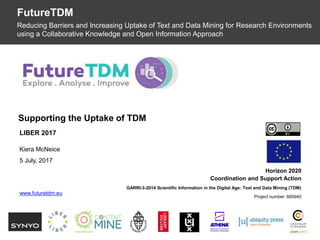
Supporting the uptake of TDM
- 1. OpenDataMonitor Horizon 2020 Coordination and Support Action GARRI-3-2014 Scientific Information in the Digital Age: Text and Data Mining (TDM) Project number: 665940 Supporting the Uptake of TDM FutureTDM Reducing Barriers and Increasing Uptake of Text and Data Mining for Research Environments using a Collaborative Knowledge and Open Information Approach LIBER 2017 Kiera McNeice 5 July, 2017 www.futuretdm.eu
- 3. What is FutureTDM? Identify and address barriers to the greater uptake of data analytics technologies in the EU • EU-funded (Horizon 2020) • September 2015 – September 2017 • 9 project partners 3
- 4. Stakeholder engagement • Knowledge Cafés • Interviews • Workshops • Surveys 4 http://www.futuretdm.eu/knowledge-cafes/
- 5. Activities in 2017 Recently published: • FutureTDM Policy Framework • Future applications and economics of TDM • Guidelines for TDM stakeholders and practitioners Coming soon: • Case studies: Best practices to support TDM • Roadmap for increasing uptake of TDM 5
- 7. FutureTDM Stakeholder Guidelines 7 • Aimed at giving concrete, practical advice • Legal guidelines • Is my TDM project lawful? Do I need expert advice? • Licensee guidelines • What makes a TDM licence reasonable and proportionate to user needs? • Data management guidelines • What do machine ‘readers’ need for TDM? • Guidelines for university policy • How can universities support TDM strategically?
- 9. Legal uncertainty around TDM 9 • What laws apply, and to which TDM activities? • Copyright, database rights, data protection… • Reading, processing, copying, publishing excerpts… • Who benefits from legal exceptions? • What is “non-commercial”? • What is a “research organisation”?
- 10. FutureTDM Legal Guidelines 10 • Breakdown of when legal considerations are relevant • Intellectual property: Do I need a licence? • Data protection: What do I need to consider? • When to seek expert legal advice
- 12. Licensing content for TDM 12 • TDM requires large datasets • Potentially from hundreds or thousands of sources • Uncertainty around who may benefit from exceptions to copyright • Many existing licences are unclear or silent on TDM activities
- 13. Licensing considerations for TDM: Reasonable and Proportionate? 13 • Does it make practical sense to distinguish between ‘commercial’ and ‘non-commercial’ research? • Does intrusive usage and activity monitoring affect researchers’ academic freedoms? • Can researchers reproduce reasonable, illustrative excerpts of content with their analysis? • Is it practical for researchers to attribute credit to every piece of content used in analysis? • Do technical protection measures prevent researchers from carrying out TDM at reasonable scales?
- 15. Data Management in the Context of TDM • Human and machine ‘readers’ have different needs • Open access does not necessarily mean practically accessible for TDM • Machine ‘readers’ need: • Machine-readable file format • Machine-readable metadata • Bulk access to content
- 16. What do Machine ‘Readers’ Need? • Key (machine-readable) metadata: • Permanent identifiers • What licences or rights apply to content • Data type, format, size • Any specific tools needed to work with the data • Data provenance and rights-holder information • Data changes and versioning • Other domain-specific metadata
- 17. Guidelines for University Policy
- 18. The Role of Universities • Universities are involved in all aspects of the TDM value chain • Content creation • Content dissemination • Development and use of TDM tools • Sharing of new knowledge and insights • …but very few in Europe have strategic policy approaches to TDM
- 19. Encouraging Development of Strategic TDM Policy • Demonstrate need • Involve stakeholders • Understand your institution • Consolidate information • Identify promoters and early adopters • Introduce incentives • Share your progress!
- 20. The Role of Libraries
- 21. How can Libraries Support TDM? • Help connect researchers with expert legal advice where needed • Consider researcher needs in the context of TDM when negotiating licences • Ensure repositories have machine-readable metadata to make TDM practically feasible • Work within universities or institutions to develop strategic approaches to supporting TDM
- 22. Questions?
